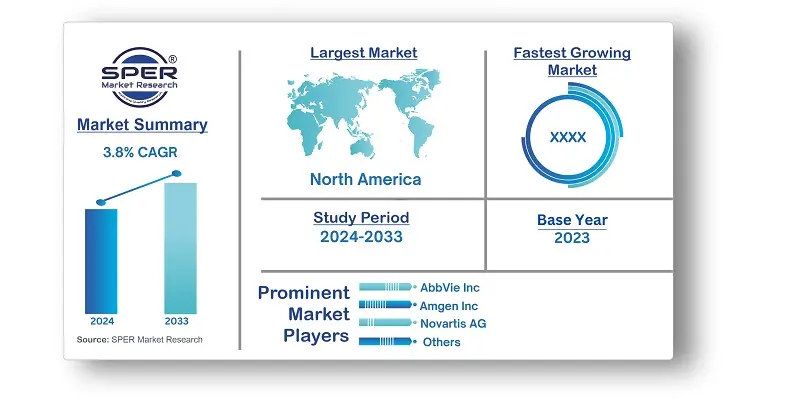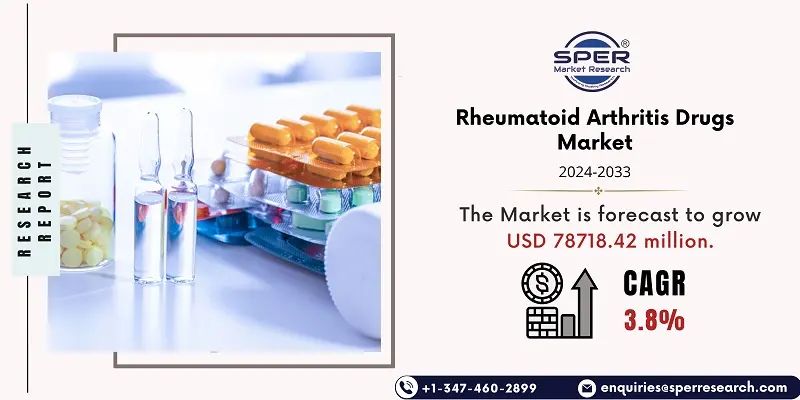
Rheumatoid Arthritis Drugs Market Growth, Size, Trends, Share, Revenue and Future Outlook
Rheumatoid Arthritis Drugs Market Size– By Drug Class Type, By Route of Administration, By Sales Channel, By Distribution Channel- Regional Outlook, Competitive Strategies and Segment Forecast to 2033
| Published: Apr-2024 | Report ID: PHAR2406 | Pages: 1 - 234 | Formats*: |
| Category : Pharmaceutical | |||
- Biocon Biologics Ltd., a division of Biocon Ltd., declared in July 2023 that HULIO (adalimumab-fkjp) injectable, a biosimilar to Humira (adalimumab), would be available in the United States for the management of rheumatoid arthritis.
- Pfizer Inc. stated in February 2022 that the Prior Approval Supplement (PAS) to the Biologics License Application (BLA) for ABRILADA (adalimumab-afzb), an interchangeable biosimilar to Humira (adalimumab), has been accepted for consideration by the U.S. Food and Drug Administration (FDA).
- A commercialization and license agreement was signed in February 2022 by Biogen Inc. and Xbrane Biopharma AB for the development, production, and marketing of Xcimzane, a preclinical monoclonal antibody that is a potential biosimilar to CIMZIA (certolizumab pegol).


| Report Metric | Details |
| Market size available for years | 2020-2033 |
| Base year considered | 2023 |
| Forecast period | 2024-2033 |
| Segments covered | By Drug Class Type, By Route of Administration, By Sales Channel, By Distribution Channel |
| Regions covered | North America, Asia-Pacific, Latin America, Middle East & Africa and Europe |
| Companies Covered | AbbVie Inc, Johnson & Johnson Innovative Medicine, Amgen Inc, Pfizer Inc, Novartis AG, Sanofi S.A, F. Hoffmann-La Roche Ltd, Merck & Co, Inc, Bristol-Myers Squibb Company, and Eli Lilly and Company. |
- Pharmaceutical Drug Manufacturer
- Rheumatoid Arthritis Treatment Centers
- Research and Development (R&D) Companies
- Government Research Laboratories
- Government Authorities and R&D Institutions
- Academic & Medical Research Institutions
| By Drug Class Type: |
|
| By Route of Administration: |
|
| By Sales Channel: |
|
| By Distribution Channel: |
|
- Global Rheumatoid Arthritis Drugs Market Size (FY’2024-FY’2033)
- Overview of Global Rheumatoid Arthritis Drugs Market
- Segmentation of Global Rheumatoid Arthritis Drugs Market By Drug Class Type (Disease-modifying Anti-rheumatic Drugs, Nonsteroidal Anti-inflammatory Drugs, Corticosteroids, Uric Acid Drugs, Others)
- Segmentation of Global Rheumatoid Arthritis Drugs Market By Route of Administration (Oral, Parenteral)
- Segmentation of Global Rheumatoid Arthritis Drugs Market By Sales Channel (Prescription-based Drugs, Over-the-counter Drugs)
- Segmentation of Global Rheumatoid Arthritis Drugs Market By Distribution Channel (Hospital Pharmacy, Retail Pharmacy, Online Pharmacy)
- Statistical Snap of Global Rheumatoid Arthritis Drugs Market
- Expansion Analysis of Global Rheumatoid Arthritis Drugs Market
- Problems and Obstacles in Global Rheumatoid Arthritis Drugs Market
- Competitive Landscape in the Global Rheumatoid Arthritis Drugs Market
- Impact of COVID-19 and Demonetization on Global Rheumatoid Arthritis Drugs Market
- Details on Current Investment in Global Rheumatoid Arthritis Drugs Market
- Competitive Analysis of Global Rheumatoid Arthritis Drugs Market
- Prominent Players in the Global Rheumatoid Arthritis Drugs Market
- SWOT Analysis of Global Rheumatoid Arthritis Drugs Market
- Global Rheumatoid Arthritis Drugs Market Future Outlook and Projections (FY’2024-FY’2033)
- Recommendations from Analyst
1.1. Scope of the report1.2. Market segment analysis
2.1. Research data source2.1.1. Secondary Data2.1.2. Primary Data2.1.3. SPER’s internal database2.1.4. Premium insight from KOL’s2.2. Market size estimation2.2.1. Top-down and Bottom-up approach2.3. Data triangulation
4.1. Driver, Restraint, Opportunity and Challenges analysis4.1.1. Drivers4.1.2. Restraints4.1.3. Opportunities4.1.4. Challenges4.2. COVID-19 Impacts of the Global Rheumatoid Arthritis Drugs Market
5.1. SWOT Analysis5.1.1. Strengths5.1.2. Weaknesses5.1.3. Opportunities5.1.4. Threats5.2. PESTEL Analysis5.2.1. Political Landscape5.2.2. Economic Landscape5.2.3. Social Landscape5.2.4. Technological Landscape5.2.5. Environmental Landscape5.2.6. Legal Landscape5.3. PORTER’s Five Forces5.3.1. Bargaining power of suppliers5.3.2. Bargaining power of buyers5.3.3. Threat of Substitute5.3.4. Threat of new entrant5.3.5. Competitive rivalry5.4. Heat Map Analysis
6.1. Global Rheumatoid Arthritis Drugs Market Manufacturing Base Distribution, Sales Area, Ingredients6.2. Mergers & Acquisitions, Partnerships, Product Launch, and Collaboration in Global Rheumatoid Arthritis Drugs Market
7.1. Global Rheumatoid Arthritis Drugs Market Size, Share and Forecast, By Drug Class Type, 2020-20267.2. Global Rheumatoid Arthritis Drugs Market Size, Share and Forecast, By Drug Class Type, 2027-20337.3. Disease-modifying Anti-Rheumatic Drugs (DMARDs)7.4. Nonsteroidal Anti-inflammatory Drugs (NSAIDs)7.5. Corticosteroids7.6. Uric Acid Drugs7.7. Others
8.1. Global Rheumatoid Arthritis Drugs Market Size, Share and Forecast, By Route of Administration, 2020-20268.2. Global Rheumatoid Arthritis Drugs Market Size, Share and Forecast, By Route of Administration, 2027-20338.3. Oral8.4. Parenteral
9.1. Global Rheumatoid Arthritis Drugs Market Size, Share and Forecast, By Sales Channel, 2020-20269.2. Global Rheumatoid Arthritis Drugs Market Size, Share and Forecast, By Sales Channel, 2027-20339.3. Prescription-based Drugs9.4. Over-the-counter Drugs
10.1. Global Rheumatoid Arthritis Drugs Market Size, Share and Forecast, By Distribution Channel, 2020-202610.2. Global Rheumatoid Arthritis Drugs Market Size, Share and Forecast, By Distribution Channel, 2027-203310.3. Hospital Pharmacy10.4. Retail Pharmacy10.5. Online Pharmacy
11.1. Global Rheumatoid Arthritis Drugs Market Size and Market Share
12.1. Global Rheumatoid Arthritis Drugs Market Size and Market Share, By Region (2020-2026)12.2. Global Rheumatoid Arthritis Drugs Market Size and Market Share, By Region (2027-2033)12.3. Asia-Pacific12.3.1. Australia12.3.2. China12.3.3. India12.3.4. Japan12.3.5. South Korea12.3.6. Rest of Asia-Pacific12.4. Europe12.4.1. France12.4.2. Germany12.4.3. Italy12.4.4. Spain12.4.5. United Kingdom12.4.6. Rest of Europe12.5. Middle East and Africa12.5.1. Kingdom of Saudi Arabia12.5.2. United Arab Emirates12.5.3. Qatar12.5.4. South Africa12.5.5. Egypt12.5.6. Morocco12.5.7. Nigeria12.5.8. Rest of Middle-East and Africa12.6. North America12.6.1. Canada12.6.2. Mexico12.6.3. United States12.7. Latin America12.7.1. Argentina12.7.2. Brazil12.7.3. Rest of Latin America
13.1. AbbVie Inc.13.1.1. Company details13.1.2. Financial outlook13.1.3. Product summary13.1.4. Recent developments13.2. Johnson & Johnson Innovative Medicine13.2.1. Company details13.2.2. Financial outlook13.2.3. Product summary13.2.4. Recent developments13.3. Amgen Inc.13.3.1. Company details13.3.2. Financial outlook13.3.3. Product summary13.3.4. Recent developments13.4. Pfizer Inc.13.4.1. Company details13.4.2. Financial outlook13.4.3. Product summary13.4.4. Recent developments13.5. Novartis AG13.5.1. Company details13.5.2. Financial outlook13.5.3. Product summary13.5.4. Recent developments13.6. Sanofi S.A.13.6.1. Company details13.6.2. Financial outlook13.6.3. Product summary13.6.4. Recent developments13.7. F. Hoffmann-La Roche Ltd.13.7.1. Company details13.7.2. Financial outlook13.7.3. Product summary13.7.4. Recent developments13.8. Merck & Co., Inc.13.8.1. Company details13.8.2. Financial outlook13.8.3. Product summary13.8.4. Recent developments13.9. Bristol-Myers Squibb Company13.9.1. Company details13.9.2. Financial outlook13.9.3. Product summary13.9.4. Recent developments13.10. Eli Lilly and Company13.10.1. Company details13.10.2. Financial outlook13.10.3. Product summary13.10.4. Recent developments13.11. Others
SPER Market Research’s methodology uses great emphasis on primary research to ensure that the market intelligence insights are up to date, reliable and accurate. Primary interviews are done with players involved in each phase of a supply chain to analyze the market forecasting. The secondary research method is used to help you fully understand how the future markets and the spending patterns look likes.
The report is based on in-depth qualitative and quantitative analysis of the Product Market. The quantitative analysis involves the application of various projection and sampling techniques. The qualitative analysis involves primary interviews, surveys, and vendor briefings. The data gathered as a result of these processes are validated through experts opinion. Our research methodology entails an ideal mixture of primary and secondary initiatives.



Frequently Asked Questions About This Report
PLACE AN ORDER
Year End Discount
Sample Report
Pre-Purchase Inquiry
NEED CUSTOMIZATION?
Request CustomizationCALL OR EMAIL US
100% Secure Payment






Related Reports
Our Global Clients
Our data-driven insights have influenced the strategy of 200+ reputed companies across the globe.






















